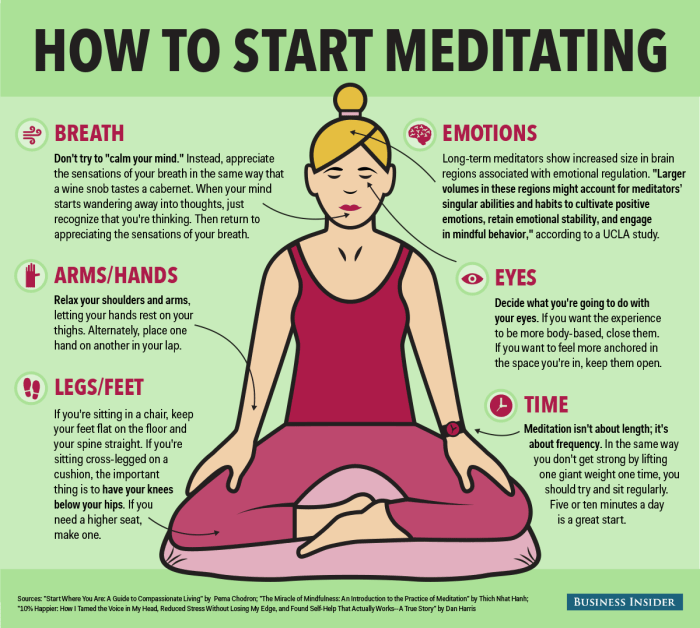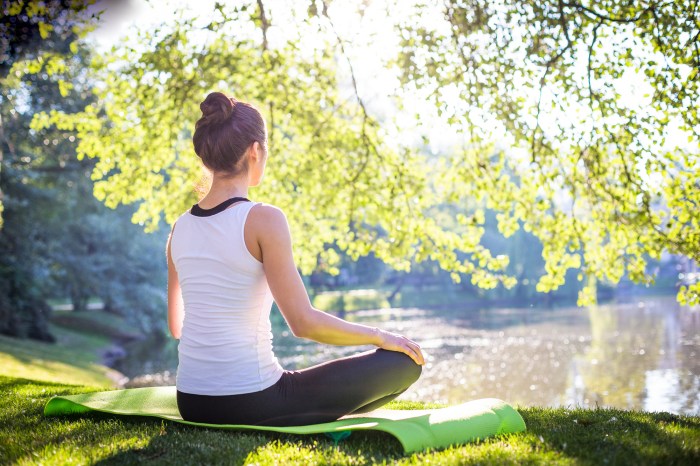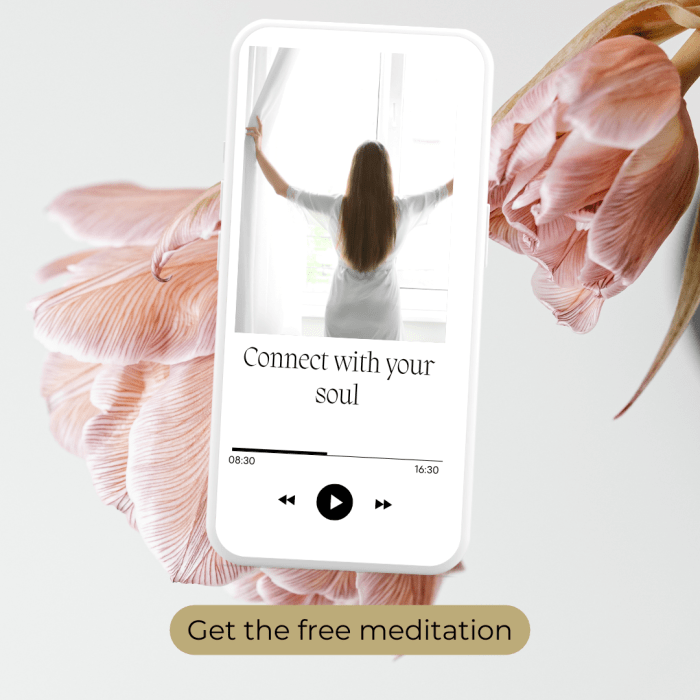Kicking off with 10 Simple Steps to Start Meditating Today, this guide will help you embark on your meditation journey effortlessly. From understanding the benefits to setting up your meditation space, this comprehensive approach will have you meditating like a pro in no time.
Benefits of Meditation
Meditation offers a wide range of benefits for both the mind and body, promoting overall well-being and enhancing quality of life. Through regular practice, individuals can experience significant improvements in various aspects of their health and daily functioning.
Mental Clarity and Focus
- Meditation helps clear the mind of clutter and distractions, allowing for improved mental clarity and focus.
- By practicing mindfulness, individuals can enhance their attention span and concentration, leading to better productivity and performance in daily tasks.
Stress Reduction, 10 Simple Steps to Start Meditating Today
- One of the most well-known benefits of meditation is its ability to reduce stress levels by promoting relaxation and calming the nervous system.
- Through deep breathing techniques and mindfulness practices, individuals can manage stress more effectively and cultivate a sense of inner peace.
Emotional Well-being
- Meditation can help individuals regulate their emotions and develop a greater sense of self-awareness, leading to improved emotional well-being.
- By practicing compassion and self-acceptance, individuals can experience greater resilience in the face of challenges and a more positive outlook on life.
Types of Meditation Techniques
When it comes to meditation, there are various techniques that one can explore. Each technique offers a unique approach to calming the mind and improving overall well-being. Let’s delve into some of the popular meditation techniques:
Mindfulness Meditation
- Mindfulness meditation involves focusing on the present moment without judgment. It encourages awareness of thoughts, feelings, and sensations as they arise.
- Practitioners often focus on their breath or bodily sensations to anchor themselves in the present moment.
- Benefits of mindfulness meditation include reduced stress, improved focus, and greater emotional resilience.
Loving-Kindness Meditation
- Loving-kindness meditation, also known as Metta meditation, involves cultivating feelings of love, compassion, and empathy towards oneself and others.
- Practitioners typically repeat phrases of well-wishes towards themselves, loved ones, acquaintances, and even challenging individuals.
- This practice can enhance feelings of connection, kindness, and overall well-being.
Transcendental Meditation
- Transcendental meditation is a technique where practitioners silently repeat a mantra to achieve a state of relaxed awareness.
- Mantras are chosen individually and are meant to help transcend ordinary thinking and access deeper levels of consciousness.
- This practice is known for promoting deep relaxation and stress reduction.
Guided vs. Self-Guided Meditation
- Guided meditation involves following the instructions of a teacher, recorded audio, or video to lead you through the meditation practice.
- Self-guided meditation, on the other hand, allows you to meditate independently without external guidance.
- For beginners, guided meditation can be beneficial in providing structure and support in developing a meditation routine.
Suitable Technique for Beginners
- For beginners, mindfulness meditation is often recommended due to its simplicity and focus on the present moment.
- Starting with short sessions and gradually increasing the duration can help beginners build their meditation practice over time.
- Exploring different techniques and finding what resonates best with you is key to establishing a sustainable meditation routine.
Setting Up a Meditation Space
When it comes to starting a meditation practice, having a dedicated space can make all the difference in creating a peaceful environment for your practice. Here’s how you can set up your own meditation space at home.
Choosing the Right Location
- Find a quiet spot in your home where you can sit comfortably without distractions.
- Consider natural light and ventilation to create a calming atmosphere.
- Avoid high-traffic areas or places with loud noises to maintain focus during meditation.
Creating a Peaceful Atmosphere
- Add elements like cushions, blankets, or a meditation cushion to make your space comfortable.
- Use calming colors or decorations, such as candles or plants, to promote relaxation.
- Keep the space clean and organized to enhance the overall tranquility of the area.
Minimizing Distractions
- Turn off electronic devices or put them on silent mode to avoid interruptions.
- Consider using earplugs or a white noise machine to block out external sounds.
- Set boundaries with family members or roommates to ensure your meditation space remains undisturbed.
Establishing a Routine

Establishing a routine is crucial when it comes to meditation. Consistency is key to reaping the full benefits of this practice. Here’s how you can make meditation a part of your daily life.
Incorporating Meditation into Daily Schedules
- Choose a specific time: Pick a time of day when you are least likely to be interrupted. This could be early morning, during a lunch break, or before bed.
- Start small: Begin with just a few minutes of meditation each day and gradually increase the duration as you get more comfortable.
- Use reminders: Set alarms or reminders on your phone to prompt you to meditate at the same time each day.
Overcoming Challenges in Maintaining a Regular Practice
- Stay committed: Remind yourself of the benefits of meditation and how it positively impacts your overall well-being.
- Be flexible: If you miss a session, don’t be too hard on yourself. Simply pick up where you left off the next day.
- Find accountability: Join a meditation group or share your progress with a friend to stay motivated and accountable.
Breathing Techniques: 10 Simple Steps To Start Meditating Today
When it comes to meditation, breathing plays a crucial role in helping us stay focused, calm, and present in the moment. By paying attention to our breath, we can anchor ourselves in the present and quiet the mind.
Common Breathing Techniques
There are several common breathing techniques used during meditation to help deepen our practice and promote relaxation:
- Deep Breathing: Involves taking slow, deep breaths to activate the body’s relaxation response and calm the mind.
- Counted Breathing: Involves counting the length of each inhale and exhale to create a rhythmic pattern and focus the mind.
- Alternate Nostril Breathing: Involves breathing in and out through one nostril at a time to balance the body’s energy and calm the nervous system.
- Breath Awareness: Involves simply observing the natural flow of the breath without trying to control it, allowing us to stay present and mindful.
Benefits of Deep Breathing
Deep breathing can have profound effects on both the mind and body during meditation:
- Calms the Mind: Deep breathing helps reduce stress, anxiety, and racing thoughts, promoting a sense of calm and relaxation.
- Relaxes the Body: By focusing on deep, slow breaths, we can release tension in the body and promote physical relaxation.
- Increases Oxygen Flow: Deep breathing increases oxygen intake, which can improve concentration, energy levels, and overall well-being.
- Enhances Mindfulness: Deep breathing enhances our awareness of the present moment, allowing us to let go of distractions and be fully present in our meditation practice.
Mindfulness and Awareness
Mindfulness and awareness are key components of meditation practice that involve being fully present in the moment without judgment. Cultivating mindfulness during meditation helps individuals become more aware of their thoughts, emotions, and sensations without getting caught up in them. This increased awareness can lead to a deeper sense of self-awareness and improved overall well-being.
Cultivating Mindfulness
- Focus on your breath: Pay attention to the sensation of your breath as you inhale and exhale, using it as an anchor to keep you present.
- Body scan: Bring awareness to different parts of your body, noticing any tension or sensations without trying to change them.
- Labeling thoughts: When thoughts arise, simply acknowledge them without attaching judgment, and gently guide your focus back to the present moment.
Benefits of Increased Awareness
- Reduced stress and anxiety: By becoming more aware of your thoughts and emotions, you can better manage stressors and reduce anxiety levels.
- Improved focus and concentration: Increased awareness can enhance your ability to stay focused on tasks and improve cognitive function.
- Enhanced relationships: Being more mindful and aware can lead to better communication and deeper connections with others.
Dealing with Thoughts and Emotions
When meditating, it’s common to be faced with distracting thoughts and emotions that can disrupt your practice. Learning how to effectively deal with these intrusions is key to maintaining focus and reaping the benefits of meditation.
Acknowledge Without Judgment
- Acknowledge thoughts and emotions as they arise without judging them as good or bad. This practice helps create a sense of detachment and allows you to observe without getting caught up in the content.
- Remember that it’s normal for the mind to wander during meditation. Instead of getting frustrated, gently guide your focus back to your breath or chosen point of concentration.
Refocusing Techniques
- Use a mantra or phrase to redirect your attention whenever distracting thoughts arise. Repeat this phrase silently to yourself to anchor your mind back to the present moment.
- Focus on your breath, counting each inhale and exhale to stay grounded and centered. This rhythmic practice can help calm the mind and bring your focus back to the meditation session.
- If emotions surface during meditation, allow yourself to feel them without getting swept away. Observe the sensation in your body and then gently guide your attention back to your breath.
Progress Tracking

Tracking progress in meditation practice is essential to see how far you’ve come and to stay motivated on your journey. Reflecting on your experiences and celebrating milestones can help you stay focused and committed to your practice.
Methods for Reflecting on Meditation Experiences
- Keep a meditation journal to jot down thoughts, feelings, and experiences before and after each session.
- Use a meditation app that allows you to track your practice and provides insights into your progress over time.
- Reflect on how meditation has impacted your daily life, relationships, and overall well-being.
Tips on Celebrating Milestones
- Set small goals for your practice and celebrate each achievement, whether it’s meditating for a longer duration or increasing your focus.
- Reward yourself with something special when you reach a significant milestone, like completing 30 consecutive days of meditation.
- Share your progress with a friend or meditation group to celebrate together and stay motivated on your journey.
- Increased Focus and Productivity: By practicing mindfulness throughout the day, you can train your mind to stay present and focused on the task at hand, leading to improved productivity.
- Reduced Stress and Anxiety: Mindfulness allows you to stay calm and centered, even in the face of stressful situations, helping to reduce overall stress and anxiety levels.
- Improved Relationships: Being mindful in your interactions with others can lead to better communication, empathy, and understanding, ultimately strengthening your relationships.
- Work Life: Incorporating mindfulness into your workday can help you make better decisions, handle challenges with grace, and maintain a positive attitude even in high-pressure situations.
- Physical Health: Mindfulness can help you listen to your body’s needs, leading to healthier habits such as proper nutrition, regular exercise, and adequate rest.
- Mental Well-being: By practicing meditation daily, you can cultivate a sense of inner peace, resilience, and emotional balance, which can contribute to overall mental well-being.
- Joining a meditation group or class allows you to learn from experienced practitioners and gain new perspectives on meditation techniques.
- Teachers can provide personalized guidance tailored to your specific needs and challenges, helping you progress more effectively in your practice.
- Being part of a supportive community can offer motivation, accountability, and a sense of belonging on your meditation journey.
- Attending meditation classes or retreats can provide immersive experiences that deepen your practice and allow you to disconnect from distractions.
- Retreats offer extended periods of practice, guidance from experienced teachers, and a supportive environment for self-reflection and growth.
- Connecting with like-minded individuals at classes or retreats can foster a sense of community and shared dedication to meditation.
- Explore online platforms, apps, or websites that offer guided meditations, virtual classes, and resources to support your practice.
- Seek recommendations from trusted sources or friends who have experience with meditation communities or teachers.
- Consider reaching out to local meditation centers, yoga studios, or spiritual organizations to inquire about classes, workshops, or teacher-led sessions.
Incorporating Meditation into Daily Life

Meditation is not just about sitting in silence for a few minutes a day; it’s about bringing mindfulness into every aspect of your life. By incorporating meditation into your daily routine, you can experience a profound shift in your overall well-being and outlook on life.
Benefits of Bringing Mindfulness into Daily Routines
Examples of How Meditation Can Positively Impact Various Aspects of Life
Seeking Support and Guidance

Seeking support and guidance in your meditation practice can be incredibly beneficial as you navigate the journey towards inner peace and mindfulness. Connecting with meditation communities or teachers can offer valuable insights and encouragement to help you stay committed to your practice.
Importance of Community and Teachers
Attending Classes and Retreats
Finding Resources and Guidance
Outcome Summary

In conclusion, starting your meditation practice doesn’t have to be daunting. By following these simple steps, you’ll soon experience the peace and clarity that comes with a regular meditation routine. Ready to begin your mindfulness journey?